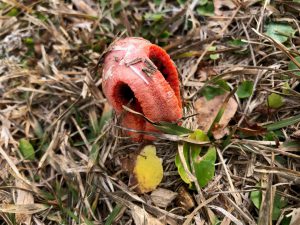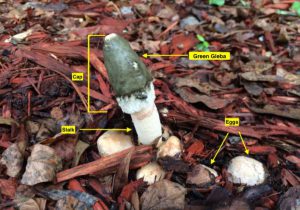
If you’ve ever had a tree cut down or die in your yard, you’ve probably experienced it. First, you’re hit with the smell—like rotting meat, maybe old garbage. Then, you notice an alien-looking pink protrusion rising up from the yard. The stinkhorn fungus, a member of the Phallaceae family, lives up to its name in both appearance and odor. There are multiple varieties of this mushroom relative, but the most common one here in northwest Florida is the column stinkhorn, Clathrus columnatus.

Matthew E. Smith, University of Florida
Like all fungi, stinkhorns thrive on decaying wood and other organic material, so it’s not uncommon to see them spring up in the aftermath of a hurricane, when trees have gone down and underground roots are decaying. Stinkhorns often appear this time of year and in the early spring, especially if we’ve had wet weather. Besides rotting tree stumps, you might see them emerging from mulched areas, where wood is also decomposing. Early on, the fungus has an egg-shaped structure, but most people don’t notice it until the mature pink/orange “stinkhorn” shows up. Why the terrible smell? This clever fungus has evolved in a way that the putrid scent it emits attracts flies and other insects, which then transport its spores throughout the landscape.
While they don’t smell great, stinkhorn fungi are considered beneficial. By breaking down organic matter, they contribute nutrients to our soils, making them available for plant uptake. Contrary to some popular beliefs, stinkhorn fungi are not poisonous to animals or people, and chemicals should never be used to remove them. If stinkhorns are too unattractive or smelly to tolerate, they can simply be removed and thrown away. Removing stumps and other decaying wood will also prevent their return.
 2
2
